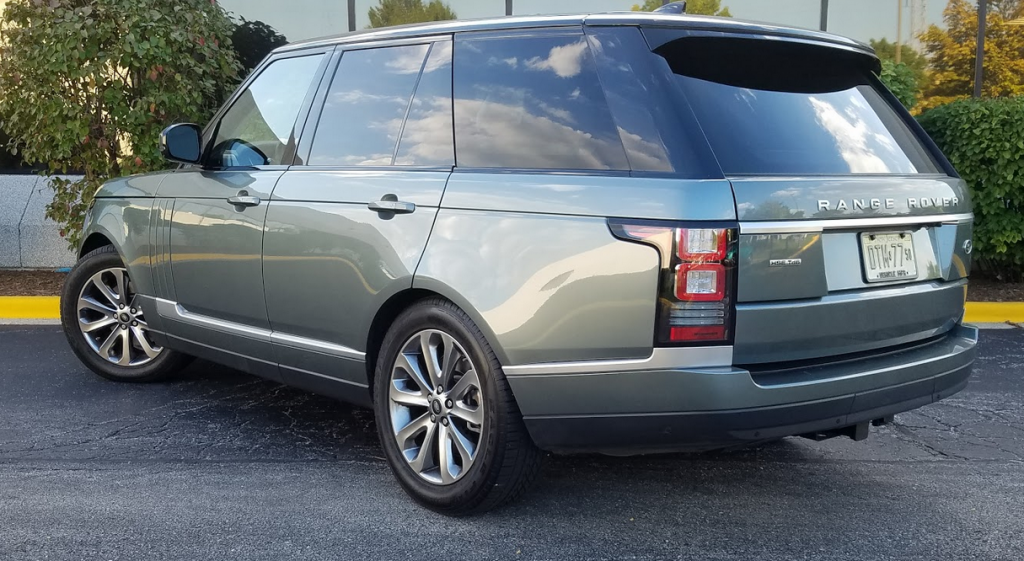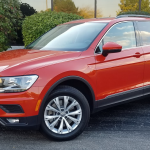
 2017 Land Rover Range Rover HSE Td6
2017 Land Rover Range Rover HSE Td6
Class: Premium Large SUV
Miles driven: 293
Fuel used: 12.3 gallons
Real-world fuel economy: 23.8 mpg
Driving mix: 60% city, 40% highway
EPA-estimated fuel economy: 22/28/24 (city, highway, combined)
| CG Report Card | |
|---|---|
| Room and Comfort | A |
| Power and Performance | B+ |
| Fit and Finish | A |
| Fuel Economy | A |
| Value | C |
| Report-card grades are derived from a consensus of test-driver evaluations. All grades are versus other vehicles in the same class. Value grade is for specific trim level evaluated, and may not reflect Consumer Guide's impressions of the entire model lineup. | |
| Big & Tall Comfort | |
| Big Guy | A |
| Tall Guy | A |
| Big & Tall comfort ratings are for front seats only. "Big" rating based on male tester weighing approximately 350 pounds, "Tall" rating based on 6'6"-tall male tester. | |
Base price: $94,650 (not including $995 destination charge)
Options on test vehicle: Vision Assist Package ($2500), Rover Tow Package ($900), Meridian premium audio system ($1850), black roof treatment ($650), 20-inch Shadow Chrome wheels ($1400), 360-degree Parking Aid ($275), Heads Up Display ($1300), Advanced Tow Assist ($400), Drive Pro Package ($2450), Park Assist ($925)
Price as tested: $108,295
Quick Hits
The great: Outstanding interior luxury, spacious cabin, good on-road driving manners for a large SUV
The good: Capable diesel engine provides good fuel economy for the class
The not so good: Optional equipment pumps up already-steep base price
More Range Rover price and availability information
John Biel
“Horses for courses,” goes an old saying. Things that are good in one setting might not be as good under different conditions.
That thought struck this driver after taking a test turn in a diesel-engine 2017 Range Rover HSE Td6 some weeks after driving a ’17 Land Rover Discovery with the same engine. In the Discovery, the 3.0-liter V6 was a marvel of quiet that hid its “oil-burner” origins extremely well. However, in the bigger Range Rover that Consumer Guide® sampled, the powerplant displayed a lot more of this engine type’s telltale clatter at idle and under acceleration—and that matched our experience with a 2016 Range Rover Sport.

Test Drive: 2017 Land Rover Discovery Diesel
Aside from the higher level of undignified racket, it’s hard to dislike the diesel V6 in the Range Rover. The middling 254-horsepower rating obscures a stout torque output of 443 lb-ft that peaks in a relative hurry at 2000 rpm. That enables rapid getaway from a standstill. Acceleration just may be a little hard to sustain. The diesel-powered Range Rover cruises easily on the highway, albeit with mid-range acceleration that comes across as “good” rather than “great.”
Another plus is decent fuel economy. Wheeling the premium-large SUV for 160 miles, this driver averaged 23.2 mpg with 55 percent city-type operation. That’s very much in line with the EPA estimates for the diesel Range Rover: 22 mpg in the city, 28 on the highway, and 24 combined. The standard transmission is a smooth and efficient 8-speed automatic. An engine-stop/start feature is also included to squeeze out additional fuel savings at full vehicle stops.

The Range Rover is improved somewhat for 2017. The hyper-expensive SVAutobiography adds a Dynamic version with a lowered suspension and distinctive trim. More generally available is a new control system with a larger 10.2-inch display screen. Added driver-assistance features include Advanced Tow Assist (which makes maneuvering a trailer easier) and Driver Condition Monitor (which checks for driver fatigue), both of which were included in option packages that went a ways toward jumping the full delivered cost to $108,295 from a base price of $94,650.
HSE standard equipment includes perforated-leather upholstery, a panoramic sunroof, 20-inch alloy wheels, automatically dimming heated and power-folding mirrors, heated and ventilated power-adjustable front seats, heated rear seats, heated leather-wrapped steering wheel, 3-zone automatic climate control, a hands-free power tailgate, and ambient interior lighting to hold up the luxury end of things. The complement of convenience and safety technologies lists Bluetooth connectivity, an audio system with HD radio and satellite radio, navigation, Land Rover’s InControl apps, and a rearview camera. Off-road-capability standards count full-time 4-wheel drive, a 2-speed electronic transfer case, “Terrain Response” that matches power application to surface conditions, and electronic air suspension at all four wheels. Other modern features like adaptive automatic-high-beam headlights, a 360-degree camera, head-up display, lane-keeping assist, blind-spot alert, and rear cross-traffic alert are options (and were included on CG’s test vehicle).

The air suspension helps to smooth out the ride. However, this somewhat high-riding truck can lean and pitch going around corners or braking forcefully. Steering is lighter than you might expect, yet still nicely weighted, and maneuverability is pretty good for a large SUV.
The quiet cabin is amply endowed with soft-touch materials on the dash, doors, and sides of the console. Even the insides of the door-storage pockets are flocked. Abundant wood trim and some bright-metal highlights heighten the ambience. Audio and navigation management is fairly directly carried out on the touchscreen. Climate controls reside lower on the dash and have dials for temperature and fan-speed settings with a limited number of buttons for other functions. The console houses well-placed buttons and a pop-up dial that govern the Terrain Response system. The space between the speedometer and tachometer dials is filled with a colorful and legible vehicle-information display, and thumb buttons on the steering wheel allow for scrolling through its menu.
Test Drive: 2017 Mercedes-Benz GLS450

The front seats are comfortable and welcoming, and include adjustable inboard pull-down armrests. Leg- and headroom are bountiful in both rows of this 5-passenger vehicle. The middle passenger in the rear seat—even an adult—won’t feel punished. Doors open wide, but rear-seat entry/exit is a little tight around feet. Step-in height is a little tall, too. Big windows provide good vision that drivers (and sightseeing passengers) will appreciate.
Front-row cabin storage benefits from good-sized door pockets; two glove boxes, one above the other (with lids that power down); dual cup holders under a slide-top cover in the console; and a covered console box that makes up in depth what it lacks in length. The console box hosts an auxiliary jack and twin USB ports. The second row sports smaller door pockets, hard-sided pull-out pouches in the backs of the front seats, and a pull-down center armrest with twin cup holders and a modest covered storage compartment. Rear passengers are provided with plug-in power points and seat-heater/climate-control buttons built into the back of the console.
At the rear is a flat-floored cargo area with a conveniently low lift-over behind a 2-piece portal with a separate transom window and bottom-hinged tailgate. Cargo room up to the window line isn’t really cavernous for a vehicle of the Range Rover’s size, but it’s still big by the standards of most SUVs. Bigger loads can be handled by dropping the backs of the 60/40-split rear seats, but they rest slightly higher than the level of the cargo floor.
The Range Rover oozes luxury and rests on a reputation of off-road capability—both of which are specialized fields. Some folks prefer one or the other; some need one or the other. Putting them together creates something even more specialized—and costly, to boot.




